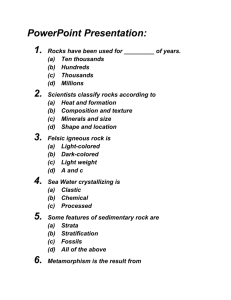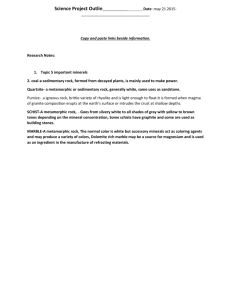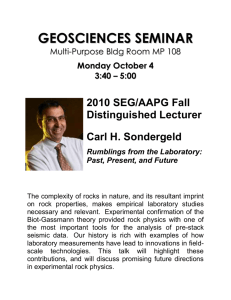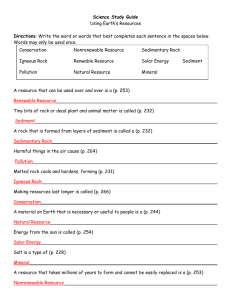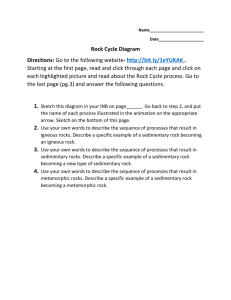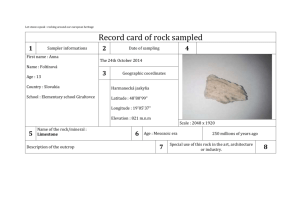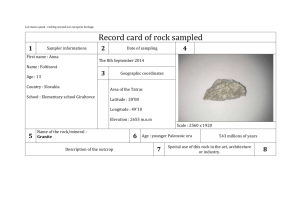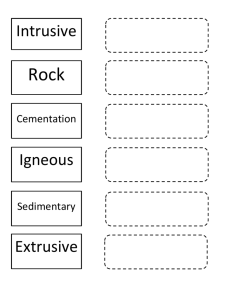Section: What Is a Mineral - SchoolWorld an Edline Solution
advertisement
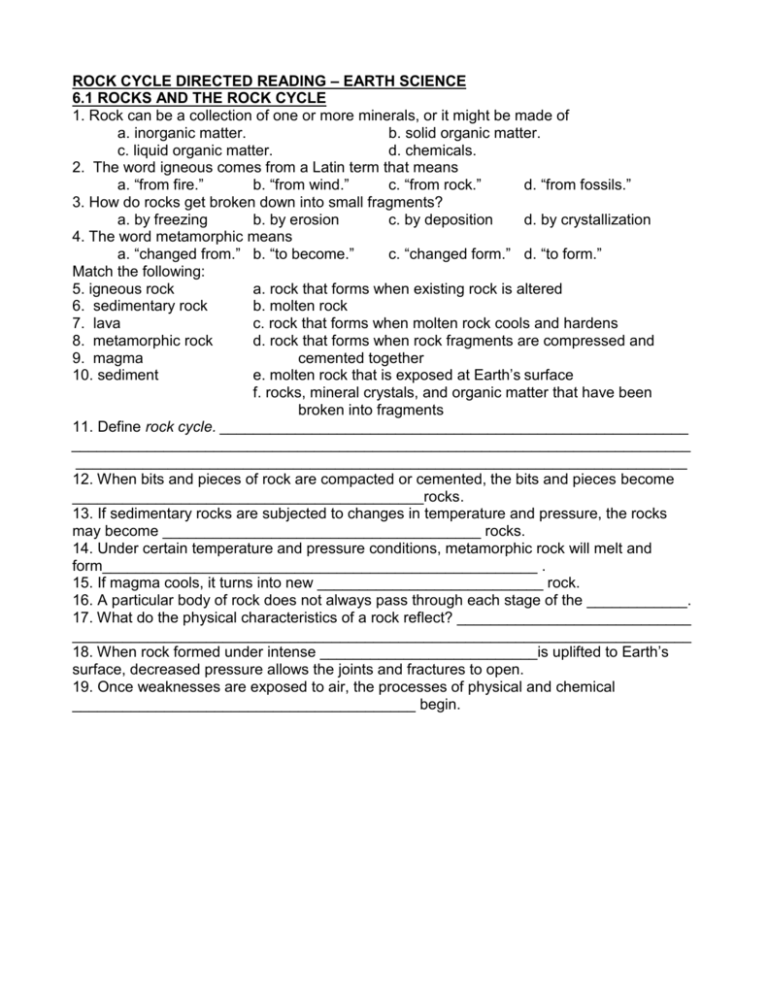
ROCK CYCLE DIRECTED READING – EARTH SCIENCE 6.1 ROCKS AND THE ROCK CYCLE 1. Rock can be a collection of one or more minerals, or it might be made of a. inorganic matter. b. solid organic matter. c. liquid organic matter. d. chemicals. 2. The word igneous comes from a Latin term that means a. “from fire.” b. “from wind.” c. “from rock.” d. “from fossils.” 3. How do rocks get broken down into small fragments? a. by freezing b. by erosion c. by deposition d. by crystallization 4. The word metamorphic means a. “changed from.” b. “to become.” c. “changed form.” d. “to form.” Match the following: 5. igneous rock a. rock that forms when existing rock is altered 6. sedimentary rock b. molten rock 7. lava c. rock that forms when molten rock cools and hardens 8. metamorphic rock d. rock that forms when rock fragments are compressed and 9. magma cemented together 10. sediment e. molten rock that is exposed at Earth’s surface f. rocks, mineral crystals, and organic matter that have been broken into fragments 11. Define rock cycle. ________________________________________________________ __________________________________________________________________________ _________________________________________________________________________ 12. When bits and pieces of rock are compacted or cemented, the bits and pieces become __________________________________________rocks. 13. If sedimentary rocks are subjected to changes in temperature and pressure, the rocks may become ______________________________________ rocks. 14. Under certain temperature and pressure conditions, metamorphic rock will melt and form____________________________________________________ . 15. If magma cools, it turns into new ___________________________ rock. 16. A particular body of rock does not always pass through each stage of the ____________. 17. What do the physical characteristics of a rock reflect? ____________________________ __________________________________________________________________________ 18. When rock formed under intense __________________________is uplifted to Earth’s surface, decreased pressure allows the joints and fractures to open. 19. Once weaknesses are exposed to air, the processes of physical and chemical _________________________________________ begin. 6.2 IGNEOUS ROCK 20. intrusive igneous rock 21. extrusive igneous rock 22. coarse-grained texture 23. fine-grained texture 24. porphyritic texture 25. glassy texture 26. vesicular texture a. the texture of quickly cooled magma that has a mixture of large and small crystals b. the texture of quickly cooled magma that contains dissolved gasses that become trapped as bubbles c. the texture of igneous rock that is composed of small crystals d. rock formed from the cooling and solidification of lava at Earth’s surface e. the texture of quickly cooled magma that contains a small percentage of dissolved gasses f. rock formed from the cooling and solidification of magma beneath Earth’s surface g. the texture of igneous rock that is composed of large mineral grains 27. How do intrusive and extrusive igneous rocks differ from each other? __________________________________________________________________________ __________________________________________________________________________ 28. What determines the texture of igneous rock? __________________________________________________________________________ __________________________________________________________________________ 29. What determines the size of crystals in igneous rock? __________________________________________________________________________ __________________________________________________________________________ 30. Large mineral crystals are commonly found in ( intrusive / extrusive ) igneous rock . 31. An example of igneous rock with a coarse-grained texture is ___________________ . 32. Two examples of igneous rock with a fine-grained texture are ___________________ and _______________________________ . 33. A rock that has a glassy texture is called ____________________________ (name). 34. What determines the mineral composition of an igneous rock? _____________________ __________________________________________________________________________ __________________________________________________________________________ 6.3 SEDIMENTARY ROCK 35. What three factors determine the characteristics of sedimentary rock? _______________ __________________________________________________________________________ 36. How are newly formed sediments transported to new locations? ____________________ __________________________________________________________________________ 37. What determines the composition of sediment? _________________________________ __________________________________________________________________________ 38. What are the two main processes that convert loose sediment to sedimentary rock? __________________________________________________________________________ 39. The process in which the volume and porosity of a sediment is reduced by the weight and pressure of overlying sediments is called _________________________________________. 40. The process in which minerals precipitate into pore spaces between sediment grains and bind sediments together to form rock is called __________________________________. 41. Sedimentary rock that forms when minerals precipitate from a solution or settle from a suspension is called a. organic sedimentary rock. b. chemical sedimentary rock. c. clastic sedimentary rock. d. elastic sedimentary rock. 42. When water evaporates, it leaves behind minerals called a. metamorphites. b. magma. c. crystals. d. evaporites. 43. Sedimentary rock that forms from the remains of plants or animals is called __________________________________________________________________________ 44. clastic sedimentary rock a. mineral that is a major component of most sandstones 45. conglomerate b. rock composed of angular fragments with sharp corners 46. breccia that range in size from fine mud to boulders 47. sandstone c. sedimentary rock that forms when fragments of 48. shale preexisting rocks are compacted or cemented 49. quartz together d. rock made up of sand-sized grains cemented together e. rock that consists of clay-sized particles that are cemented and compacted f. rock composed of rounded fragments sized from fine mud to boulders 50. In general, how do sediment particles that travel long distances differ from those that have traveled short distances? _________________________________________________ __________________________________________________________________________ 6.4 METAMORPHIC ROCK 51. Metamorphic rock forms from which three types of rock? __________________________ __________________________________________________________________________ 52. Hot fluids, heat, and _____________________ cause some minerals to change into other minerals. 53. Minerals might change in size or shape, or they sometimes separate into _____________ that give rocks a layered appearance. 54. Define contact metamorphism.) _____________________________________________ __________________________________________________________________________ 55. Define regional metamorphism. _____________________________________________ __________________________________________________________________________ 56. In what two ways are metamorphic rocks classified? _____________________________ __________________________________________________________________________ 57. foliation a. a coarse-grained rock that forms when large amounts of heat and 58. slate pressure are exerted on slate 59. schist b. the metamorphic rock texture in which mineral grains are arranged in 60. nonfoliated planes or bands 61. quartzite c. a nonfoliated rock formed when quartz sandstone is metamorphosed 62. marble d. the metamorphic rock texture in which mineral grains are not arranged in planes or bands e. a foliated rock that forms when pressure is exerted on the sedimentary rock shale f. a metamorphic rock that forms from the compression of limestone
